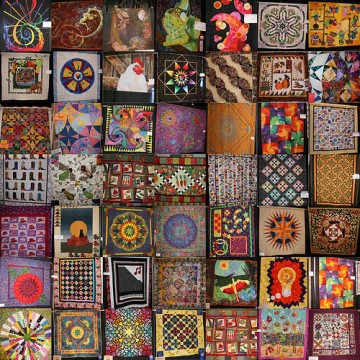
Throughout time, people have incorporated storytelling and art making into the creation of everyday practical objects. For example, we can see immense artistry in the bead work done by Aboriginal peoples of North America in everything from the needlework done on shoes to the beading on bassinets and other items. Although these objects were created for practical purposes, the desire to make them beautiful was still a significant motivator.
Quilting is one such art form, practical yet beautiful, which is estimated to date back to ancient Egypt.
The earliest surviving quilt is from approximately the first century BC to the second century AD…. Piecing fabric together is also very old. It was more often used for clothing but also occasionally for decorative objects. (Source)
The August 2009 issue of Intelligent Life has a great article about a quilting project the Victoria & Albert Museum is doing with inmates at Wandsworth prison in London, the results of which will be displayed at the Museum in an exhibition which opens in the spring of 2010. According to the V&A the history of ‘Fine Cell Work’ dates back to the early 1800s when a Quaker named Elizabeth Fry was inspired to start the British Ladies Society for the Reformation of Female Prisoners after visiting Newgate Prison. As for why prisoners today are interested, according to the V&A,
Many of the Fine Cell Work stitchers acknowledge not only the reassuring rhythmic repetition of the act of sewing, but also the cultural meaning attached to the objects that they produce. There is often a great poignancy for participants in offering up their own time and designs for public consumption, and the realisation that something important to them is appreciated by the rest of society. A prisoner’s comment that ‘we’re like a forgotten community’ acknowledges the shared experiences of those within the prison walls, but also the strong sense of alienation that comes into being when entering or leaving the prison gates. (Source)
In addition to viewing the work done at Wandsworth, visitors to the V&A exhibition will get to see the Rajah Quilt, a stunning 2815 piece quilt created by female convicts in 1841 during a boat journey from England to Tanzania.
Quilts image by Asalam.




